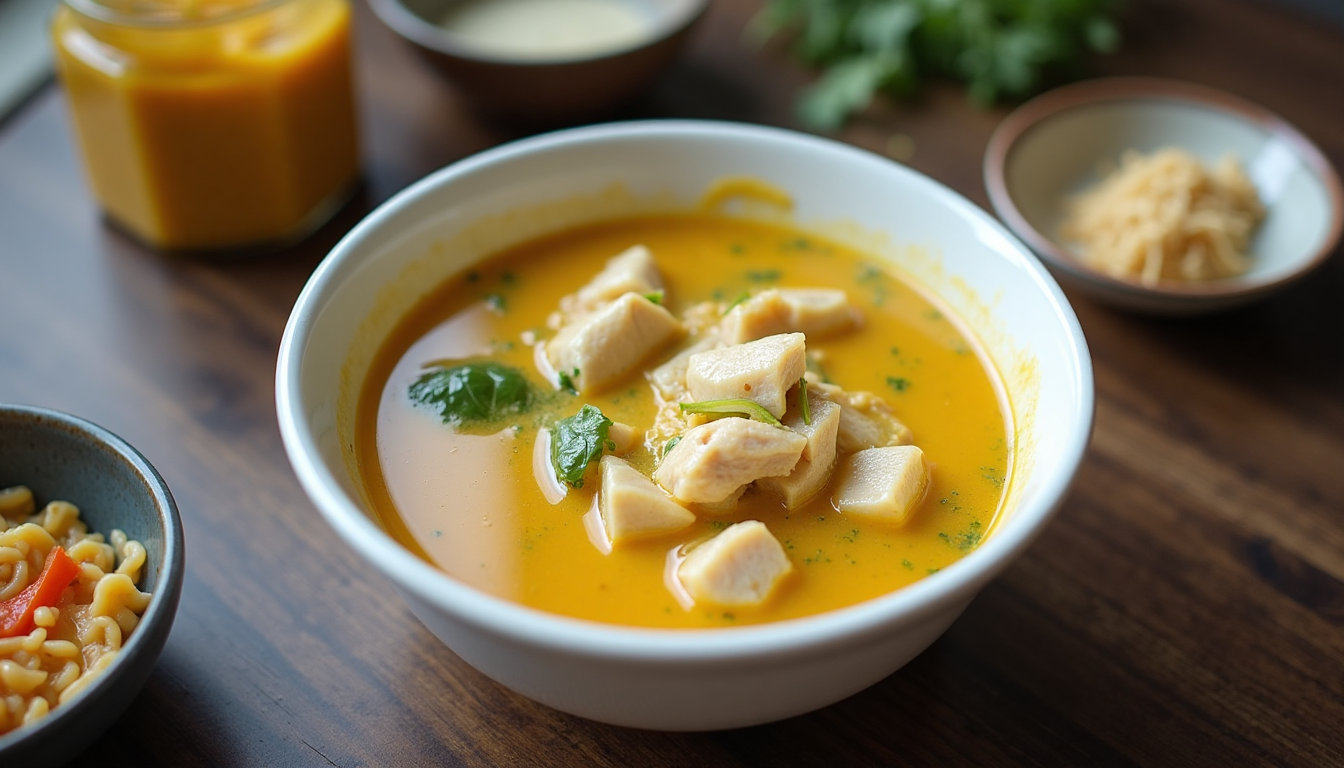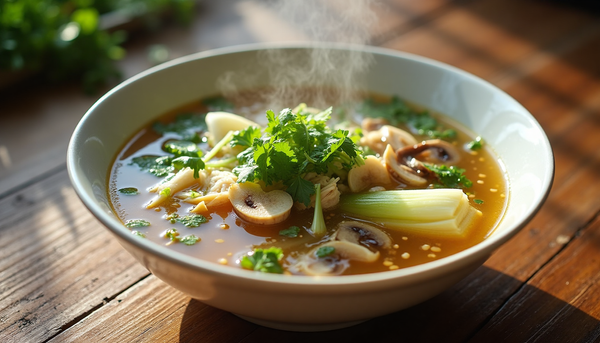Why Your Thai Curry Tastes Like Disappointment (And How to Fix It)

Why Your Thai Curry Tastes Like Disappointment (And How to Fix It)
Look, I'm gonna be straight with you. That Thai curry you made last week? The one where you dumped some curry paste into coconut milk and called it a day? Yeah, that wasn't Thai curry. That was coconut soup with delusions of grandeur.
I learned this the hard way during my first attempt at recreating the mind-blowing fish curry I had at a tiny street stall in Bangkok. You know the kind of place – plastic stools, questionable hygiene standards, and food so good it makes you question every meal you've ever eaten. I came home, bought some yellow curry paste from the Asian market, and proceeded to create what can only be described as expensive disappointment in a bowl.
The problem wasn't the recipe I found online (though let's be honest, most of those are trash). The problem was that I didn't understand the why behind Thai curry. I was following steps without grasping the technique. And technique, my friends, is everything.
The Four Pillars Nobody Talks About
Here's what those glossy food blogs won't tell you: Thai curry isn't about the curry paste. It's about balance. Every great Thai curry achieves perfect harmony between four elements:
Sweet (coconut sugar or palm sugar) Sour (lime juice or tamarind) Salty (fish sauce or salt) Umami (more fish sauce, honestly)
Most home cooks nail the coconut milk part because, let's face it, coconut milk is forgiving. But they completely ignore this balance, and that's why their curry tastes flat. It's like a band where only the bass player showed up.
When I finally figured this out – after ruining approximately seventeen pounds of perfectly good fish – my curry game changed completely. And now I'm gonna share that knowledge with you because nobody deserves to suffer through mediocre curry.
Let's Talk About Fish Selection (Because It Matters More Than You Think)
The original recipe I'm riffing on suggests cod, halibut, snapper, or tilapia. All solid choices. But here's my chef take: cod is your best friend for curry.
Why? Three reasons:
- It's forgiving. Cod doesn't turn into rubber if you overcook it by thirty seconds like some other white fish (cough halibut cough).
- It actually has flavor. Unlike tilapia, which tastes like the aquatic equivalent of plain toast.
- The texture holds up. You want fish that flakes but doesn't disintegrate into sad little pieces floating in your curry.
That said, if you're feeling fancy, try this with chunks of salmon. I know, I know – salmon in Thai curry sounds wrong. But trust me on this one. The richness plays beautifully with yellow curry paste, and it's become my secret weapon for impressing dinner guests.
The Curry Paste Situation
Let's address the elephant in the room: curry paste quality. That little plastic container from your regular grocery store? It's probably fine, but it's not going to blow your mind. If you have access to an Asian market, grab a can or jar from there instead. Look for brands like Mae Ploy or Aroy-D.
But here's the thing about yellow curry paste specifically – it's the most beginner-friendly option. Green curry paste will set your mouth on fire and demand respect. Red curry paste has attitude for days. Yellow curry paste? It's like the friendly golden retriever of curry pastes. Warm, approachable, with just enough complexity to keep things interesting.
Start with 2 tablespoons if you're curry-shy, 3 if you like to live a little. You can always add more, but you can't take it back.
My Method (AKA How to Actually Build Flavor)
Here's where I'm gonna diverge from that recipe you saw earlier. Most instructions tell you to sauté everything together like some kind of vegetable party. But that's not how you build layers of flavor.
Step 1: Bloom the Aromatics
Heat your oil (coconut oil if you have it, but olive oil works fine). Add your minced garlic and ginger. Let them get fragrant – about 30 seconds. Your kitchen should smell like heaven.
Step 2: Wake Up the Curry Paste
Add your curry paste directly to the aromatics. This is crucial – you want to fry that paste for a solid minute, maybe two. It should start to smell more complex, less raw. Some people call this "blooming" the spices. I call it "waking them up from their jar nap."
Step 3: Temper the Coconut Milk
Here's where most people go wrong. They dump the entire can of coconut milk in at once. Don't do that. Add about 1/4 cup first, just enough to create a thick paste with your curry mixture. Let it bubble and get happy for another minute.
Then add the rest of the coconut milk. This technique prevents the coconut milk from breaking and gives you a much silkier final product.
Step 4: Build Your Base
Add your coconut sugar (or brown sugar – I won't judge), fish sauce, and about half your lime juice. Taste it. This is your base, and it should already taste pretty damn good. If it doesn't, add more fish sauce. Seriously, fish sauce is your secret weapon here.
Step 5: Add Vegetables Strategically
Not all vegetables cook at the same rate. Add your harder vegetables (carrots, onions) first. Give them a few minutes to start softening. Then add quicker-cooking stuff like broccolini or bell peppers.
Step 6: The Fish Finale
Finally – finally – add your fish. Nestle those pieces into the curry like you're tucking them into bed. Cover the pan and let them gently poach in that beautiful, aromatic liquid.
White fish typically needs 4-6 minutes depending on thickness. You'll know it's done when it flakes easily with a fork. Don't poke at it constantly – let it do its thing.
The Tasting and Adjusting Dance
This is where the magic happens. Before you serve, taste your curry. Really taste it. Is it missing something? Here's your troubleshooting guide:
Tastes flat? Add more fish sauce (salt) or lime juice (acid). Too salty? Add a pinch more sugar or a splash of coconut milk. Missing oomph? More lime juice. Always more lime juice. Too sweet? A tiny splash of rice vinegar or more lime.
The goal is balance. When you taste it, you shouldn't be able to identify any single flavor dominating. It should taste like... more. Like the sum is greater than its parts.
Beyond the Basic Recipe
Once you've mastered this technique, the world is your oyster. Or your curry, I guess. Here are some variations I've fallen in love with:
The Bangkok Street Cart Special: Add a handful of Thai basil at the very end and a thinly sliced Thai chili if you're feeling brave.
The Pescatarian's Dream: Throw in some shrimp along with the fish. Add the shrimp in the last 2-3 minutes.
The Vegetable Garden: Skip the fish entirely. Use firm tofu, and add seasonal vegetables. Eggplant and curry are best friends, just saying.
The Fancy Pants Version: Use coconut cream instead of coconut milk, add a stalk of lemongrass (bruised and halved), and finish with torn kaffir lime leaves if you can find them.
Let's Talk Sides for a Hot Minute
Rice is traditional and perfect. But here's my controversial take: curry over rice noodles is criminally underrated. The noodles soak up the sauce in a way that rice just can't match. Try it with fresh rice noodles if you can get them, or even just linguine in a pinch.
And please, for the love of all that's holy, serve this with lime wedges. Fresh lime juice brightened everything and gives your dinner guests the power to customize their experience.
A Quick Note on Cultural Appreciation
Before we wrap this up, let's have a quick chat about cultural appreciation versus appropriation. I'm calling this "Thai-inspired" curry because I'm not Thai, and I've probably taken some liberties with traditional methods. That's okay! Cooking is cultural exchange, and flavors don't belong to any one person.
But here's the thing – when we cook food inspired by other cultures, we owe it to those cultures to do it thoughtfully. Learn about the techniques. Understand the why behind the ingredients. Give credit where it's due. And for heaven's sake, don't claim you invented something that's been around for centuries.
This curry exists because of the incredible culinary traditions of Thailand. I'm just trying to make those techniques accessible to home cooks who might be intimidated by the idea of "authentic" Thai cooking.
Your Homework Assignment
Here's what I want you to do: make this curry. But don't just follow the steps blindly. Taste at every stage. Notice how the flavors develop. Pay attention to the balance of sweet, sour, salty, and umami.
Then, make it again with your own modifications. Maybe swap the fish for chicken thighs. Or add some vegetables from your farmer's market haul. Or try red curry paste instead of yellow.
Cooking is a conversation between you and your ingredients. The more you practice, the better you get at understanding what they're telling you.
The Final Word
Look, I'm not saying this curry will transport you to a Thai beach at sunset or cure your existential dread. But it will be a damn sight better than whatever you've been making. And in a world full of disappointing takeout and expensive restaurant meals, being able to make something this good at home feels like a small act of rebellion.
Plus, your kitchen will smell incredible for hours afterward. Which is really just a bonus gift to your future self.
Now stop reading about curry and go make some curry. Your dinner guests (or just you, eating straight from the pan at 9 PM in your pajamas) will thank you.
What's your biggest curry disaster story? Drop it in the comments – I promise mine are worse.




